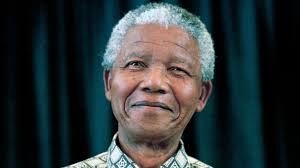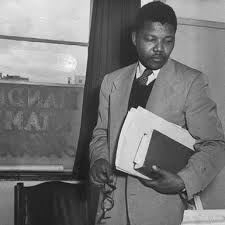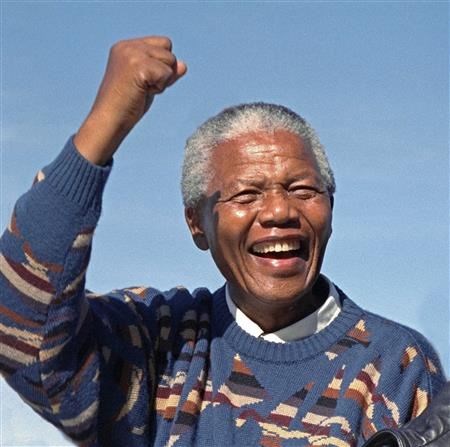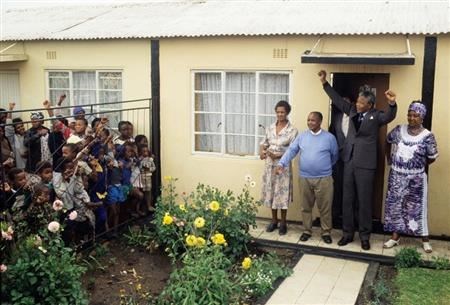 |
| (http://www.biography.com/people/nelson-mandela-939 ()) |
Nelson R. Mandela was born on July 18, 1918 in the village Mvezo, Transkei. He studied law at Fort Hare University and University of Witwatersrand. Mandela was a well known politician, philanthropist, and anti-apartheid revolutionary in South Africa. He became the first black president in South Africa in 1994. He participated in many protests for race equality and poverty. Nelson Mandela was an inspiration to many people around the world because no matter how hard things got for him, he never stopped fighting for what he believed in.
 |
| Nelson Mandela at the Defiance Campaign (http://www.usatoday.com/story/news/nation-now/2014 (Kathrine Lackey)) |
In 1942 Nelson Mandela became actively involved in the anti-apartheid movement, the anti-apartheid movement was a British organization that opposed South Africa's system of apartheid. In 1944, Mandela joined the African National Congress (ANC) and helped form the ANC Youth League. The ANC Youth League was the youth wing of the African National Congress. On December 5, 1955, Mandela and a few others were arrested for their political advocacy. That arrest later led to the 1956 Treason Trial. Mandela traveled to Pietermaritzburg days before the end of the Treason Trial to the All-In Africa Conference. The conference concluded that Mandela should write to their Prime Minister asking for a national convention for a non-racial constitution. Mandela and 28 others were not found guilty for their crime. Immediately after the Treason Trial, Mandela and a few others went underground to plan a national strike. Mandela, who believed in peaceful protests, saw that the only way to make change happen would be armed protests. On January 11, 1962, Mandela left South Africa, under the name David Motsamayi, to travel around Africa and England. He tried to gain support for the protest he was planning. Mandela went to Ethiopia and Morocco to get military training. He returned to South Africa in July of 1962. He was arrested on August 5, 1962 for leaving the country without a permit and promoting workers to strike. He was found guilty and was sentenced to five years prison at Pretoria Prison. On May 27, 1963 he was transferred to Robben Island Prison, he returned to Pretoria Prison on June 12, 1963. A month after he was transferred back to Pretoria Prison, the police many of Mandela's comrades at Liliesleaf.
 |
| Mandela after his release from prison (http://www.cnn.com/2013/12/05/world/africa/nelson- (Faith Karmini)) |
On October 9, 1963, Mandela and 10 others were put back on trial for sabotage. That trial became known as the Rivonia Trial. On July 11, 1964, Mandela and 7 others were convicted and the very next day sentenced to life in prison. Mandela and 5 others went to Robben Island prison. While at Robben Island, he was constantly harassed by the white prisoners. Mandela was classified as the "lowest grade prisoner" so he was only allowed 1 letter and visit every six months. In 1967, prison conditions finally got better for Mandela and all black people there. He got pants instead of shorts and the quality of their food got better. While Nelson was in prison, his mother died (1968) and his eldest son died (1969). He wasn't allowed to attend either of their funerals. In March of 1982, Mandela was moved to Pollsmoor Prison with 4 others. Conditions at Pollsmoor Prison were better than Robben Island's. At Pollsmoor, Mandela was allowed 52 letter a year (one each week) and he got to make the roof garden. Sometime in 1985, he left the prison for prostate surgery. When he returned in November 1985, he was held alone. While Mandela was at Pollsmoor, he was meeting secretly with Minister of Justice Kobie Coetsee. Kobie arranged meetings between Mandela and a few government figures. They agreed to release all the political prisoners and the legislation of the ANC.
 |
| Nelson Mandela outside of Victor Vester Prison (http://www.slate.com/articles/news_and_politics/ga (slate.com)) |
On August 12, 1988, Mandela was diagnosed with tuberculosis when he went to the hospital. He was transferred to Victor Vester Prison after 3 months in the hospital. He spent his last fourteen months of imprisonment at Victor Vester Prison, but it was a very nice prison. The prison was a warder's house with a personal chef! There, he was able to have many people over as long as he didn't leave the prison's grounds. Mandela was finally released from prison on February 11, 1990. When Mandela was released from prison, he still fought to end white minority rule. In 1993, Nelson Mandela and Frederik Willem de Klerk won a Nobel Peace Prize "for their work for the peaceful termination of the apartheid regime, and for laying the foundations for a new democratic South Africa". In 1994, Mandela was elected as the first black and the first democratically elected president in South Africa. Mandela stepped down from office after one term in 1999. Mandela tried living a simple and donated one-third of his annual income the Nelson Mandela Children's Fund which he founded in 1995.
Nelson Mandela died December 5, 2013 at his home in Johannesburg, South Africa. He was a hero and inspiration for many people because he never gave up on what he believed in. Even after his 27 year prison sentence, he still fought for racial rights and equality throughout South Africa.
Page created on 12/13/2014 3:43:40 PM
Last edited 12/13/2014 3:43:40 PM
